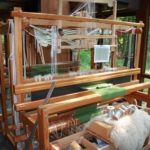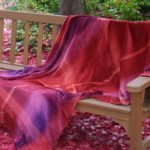Nancy Kronenberg at her 65-inch loom
By Jane Keller Gordon, Contributing Writer
Carlisle – Nancy Kronenberg’s mantra, “I haven’t done that, that’s what I want to do,” was woven into her career as a computer software engineer. Now at age 71 and retired, it is also her driving force as a professional hand weaver. Fundamental to both passions is her deep knowledge of physics and mathematics, and her focus on logic.
Kronenberg lives in an Acorn Deck house set amidst the woods in Carlisle, with her husband Paul Beck, also a retired computer software engineer. The house is filled with looms, fabrics, and books.
Her beginnings were all about physics. Kronenberg’s parents, grandfather, and uncle were physicists. She followed the same path as a physics major at Cornell University, and a graduate student at Northeastern University. But that was not meant to be.
She segued to computer software engineering, first at the Princeton-Pennsylvania Accelerator, where she was a trainee systems programmer. She moved onto Applied Data Research, where she worked on minicomputer applications. In particular, she was part of a team that developed a pattern-editing program, which controlled an electronic knitting machine.
This wasn’t Kronenberg’s first exposure to textiles. Growing up, her grandmother introduced her to fibers and the creative process of knitting and sewing.
Kronenberg left Applied Data for a storied career at DEC (Digital Equipment Computers), where she achieved the highest ranked job of any women, “Corporate Consulting Engineer.”
From 1978 to 1995 at DEC, Kronenberg focused her expertise on super minicomputers; always choosing to take on new projects that would expand her knowledge base. Highlights included working on the DEC’s operating system (VMS) to support computer cluster technology, and new central processing units (CPUs). She was the architect of the port of VMS to the new DEC Alpha CPU architecture. About that project she said, “Sometimes you start with a blank sheet of paper. But this one was scribbled all over and had to be put back together.”
As DEC wound down and staff moved out of the old textile mill in Maynard, Kronenberg was in the second to last group to leave. She said, “The five of us could walk and see the empty cubes, and the old hydroelectric system on Assabet River… If you wore crepe soles, they would turn black and soft and gooey from the lanolin still left on the mill floor.”
Next up for Kronenberg was a job at AVID, a company that did video editing. Following her mantra, she embarked on a new field, with an unfamiliar programming language. There, her team won an Emmy plaque for creating a multi-camera editing program.
Along the way, in 1969, Kronenberg was attracted to weaving by her friend Leonie Brinkema. She took a class, bought a portable loom, and began dashing off mohair scarves for fun. While at DEC, she moved up to a 45-inch jack loom. Much of her early pieces were heavy tapestry rugs.
(Brinkema became a United States district court judge who presided over the case of 9/11 conspirator Zacarias Moussaoui. He was given six life sentences without parole.)
Retired since 2001, Kronenberg devotes her time to expanding her repertoire of weaving through reading books, attending classes, and actively participating in the Weavers’ Guild of Boston, where she has earned a Journeyman rating. She commented, “You could study weaving for ages and still not know everything.”
Kronenberg draws most of her weaving patterns from books. She uses a weaving application on her computer to bring together the basic elements. Finally, she prints out the pattern and sets up her loom according to the basic repeats and edits.
She creates housewares, scarves, shawls, small rugs, and wall hangings, all with precise patterns on her jack loom, and also a 65-inch countermarche loom. She works with a variety of fibers: wool, alpaca, and wool from rare breeds of sheep in England.
“I like the sheepy smell of loom fiber, and the creative process. I like the history of weaving and the part that the animals play in our lives,” she said.
Looking back, she can see that her grandmother’s tutelage, her work on the knitting machine at DEC, and color and Photoshop work at Avid all contributed to her expertise as a weaver.
Kronenberg said, “I always knew that this was going to be my second occupation. I have done all this work of an analytical type. I wanted to do something more engaging with the art side.”
“You can only live one life but you can have two occupations,” she added.
Her work is available through her website, www.rosepath.com. She does commissioned work as well.

Photo/Jane Keller Gordon













